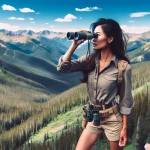Colorado is a backpacker’s paradise, with its towering Rocky Mountains, alpine lakes, and vast wilderness areas just begging to be explored. From easy loops to challenging high-altitude treks, 3-day trips allow you to experience the best of what Colorado backpacking has to offer.
In This Article
This article will equip you with everything you need to plan an epic backpacking adventure in Colorado. You’ll discover breathtaking trails, learn backcountry navigation techniques, get packing checklists and gear recommendations, and more. By the time you finish reading, you’ll be itching to lace up your boots and hit the Colorado trails!
TL;DR
- Colorado has endless backpacking route options for 3-day trips catering to all skill levels.
- Proper preparation and planning is key – use checklists and research trails, permits, maps, and gear ahead of time.
- Focus on safety and minimizing environmental impact while enjoying Colorado's stunning mountain scenery.
Local Experiences and Culture
Immerse yourself in Colorado’s distinctive local culture and landscapes by getting off the beaten path on a 3-day backpacking trip. Wander through historic mining towns like Silverton and Leadville to appreciate the state’s rugged pioneering history before venturing into the mountains.
Attend a local festival or event to experience authentic music, food, and crafts. The Colorado Dragon Boat Festival, Jazz Aspen Snowmass, and Telluride Bluegrass Festival are just a few of the state’s popular cultural celebrations. Trying unique regional dishes like green chili and Colorado lamb while conversing with locals is a highlight for many backpackers.
While on the trail, respect all wilderness regulations and Leave No Trace principles to preserve Colorado’s natural splendor and wildlife habitats for future generations. Limit your impact by staying on designated trails, packing out all trash, and properly disposing of human waste.
Pre-Trip Planning and Preparation
Meticulous pre-trip planning is crucial when backpacking in Colorado’s remote wilderness. Carefully study area maps and trail descriptions to choose your route and identify water sources, campsites, and bailout points. Account for mileage, elevation gain, terrain, and difficulty level to select trails matching your fitness and experience level.
Obtain required permits and passes like recreation area entry passes and overnight camping permits from ranger stations, land agencies, or online ahead of time. These regulate use and minimize environmental impact in wilderness areas.
Prepare a comprehensive Colorado backpacking gear checklist, including essentials like:
- Backpack and shelter
- Sleeping bag, pad, and pillow
- Hiking shoes or boots
- Lightweight, quick-dry clothing layers
- Water treatment supplies
- Cookset, utensils, and food
- First aid kit and medications
- Map, compass, GPS device
- Flashlight or headlamp
- Fire starter
- Knife or multi-tool
- Toilet paper and trowel
Proper layering, nutrition, and fitness conditioning at altitude are also key for comfort and safety.
Gear and Equipment
Choose durable, specialized backpacking gear designed to withstand rugged mountain terrain while minimizing weight. A waterproof, well-fitted 60-70 liter backpack with an internal frame offers optimal comfort and stability for multi-day Colorado treks.
Look for a lightweight, 3-season backpacking tent designed to withstand wind and rain when camping above tree line. Similarly, choose a compact down or synthetic sleeping bag with a temperature rating of 20 degrees Fahrenheit or less, depending on the season.
For summer alpine hikes, essential clothing layers include moisture wicking base layers, an insulating mid layer like fleece, waterproof and breathable outer shell jacket and pants, gloves, warm hat, and sun protective clothing like a wide brimmed hat and sunglasses.
Select sturdy hiking boots or shoes with ankle support and rugged traction. Break them in by wearing them frequently leading up to your trip to prevent painful blisters. Trekking poles are also highly recommended to improve stability, reduce strain on knees during descents, and assist with stream crossings.
On-Trail Experience
Lace up your boots and step into Colorado’s majestic wilderness to experience the freedom and exhilaration of backpacking first-hand. Alpine lakes and streams shimmer below craggy, 14,000-foot peaks as you traverse high mountain passes bursting with colorful wildflowers in summer. Watch sunlight slowly creep across granite walls at sunrise from a backcountry campsite. Marvel at the star-filled night sky without any light pollution.
Enjoy the physical challenge of lugging a pack up steep switchbacks, made rewarding by mountain vistas unfolding around each bend. Feel your worries fade away with every step on the trail. Appreciate the simplicity of living with just the bare necessities. Bond with your hiking companions and meet interesting people from around the world on the trail.
Stay vigilant for lightning, wildlife like mountain goats, bears, and moose, falling rocks, and rapid weather changes at altitude. Getting caught in an afternoon thunderstorm above a tree line is extremely dangerous. Always yield to descending hikers and livestock to avoid falls. Follow proper food storage protocols and give animals plenty of space.
Navigation and Safety
Carry a topographic map in a waterproof case and know how to read it along with a compass for navigation. Map key terrain features and use triangulation to pinpoint your location. Watch for cairns and trail markers to stay on route. A GPS device or smartphone app like Gaia GPS provides additional navigational assistance but doesn’t rely solely on electronics.
Acclimatize to altitude by hydrating well in the days leading up to your trip and ascending slowly once on the trail to prevent altitude sickness. Be able to recognize early warning signs like headache, nausea, and fatigue. Descend immediately if symptoms worsen or persist over 24 hours.
Pack a water filter or treatment tablets to safely collect water from alpine streams and lakes. Boil or chemically treat all found water to protect against bacteria, viruses, and parasites.
Prepare for emergencies by packing a first aid kit, rescue whistle, signal mirror, and fire starter. Share your detailed itinerary with someone at home and establish check-in procedures in case an SOS call is needed. Satellite communication devices like personal locator beacons and satellite phones provide additional emergency support when beyond cell phone range.
Environmental Considerations
Help preserve Colorado’s natural splendor for future generations by strictly following Leave No Trace ethics. Stay on the trail to avoid trampling fragile alpine vegetation. Be prepared to pack out all trash since bins are not provided in the backcountry. Dig cat holes 6-8 inches deep to bury solid human waste at least 200 feet from water sources, camps, and trails. Use biodegradable soap and wash dishes, yourself, and clothing at least 200 feet from lakes and streams. Follow all regulations related to campfires and be extremely cautious with any ignition source.
Obtain required permits and practice “leave no trace” to protect ecosystems and respect all designated wilderness regulations so these special areas remain pristine for the future.
Post-Trip Reflection
Extend and share your Colorado backpacking memories by compiling photos and keeping a written journal of insights, lessons learned, inspirational moments, and practical advice for future trips. Consider posting photos, trip reports, gear reviews, or videos to online forums and blogs to assist fellow adventurers with their own trip planning.
Give back by getting involved in conservation efforts to maintain Colorado trails and public lands, such as volunteering for a trail work day with an organization like the Colorado Trail Foundation.
No matter how you choose to commemorate your Colorado backpacking adventures, integrating reflections into post-trip life keeps the magic alive until you start planning your next Rockies escape!
FAQ
What are some recommended 3-day backpacking loops in Colorado?
Some recommended 3-day loops include the Lost Creek Wilderness Loop, Chicago Basin Loop, the Maroon Bells-Snowmass Wilderness Loop, and the Blue Lakes Trail.
What are the best months to go backpacking in Colorado?
The best times for backpacking in Colorado are July through September when the snow has melted from high passes and wildflowers are in bloom. However, during monsoon season in August, beware of afternoon thunderstorms.
How difficult is backpacking in Colorado compared to other places?
Backpacking in Colorado’s high-altitude mountain terrain with significant elevation gains and losses is more challenging than hiking in lower elevations. Fitness conditioning and proper acclimatization are key.
What type of footwear do I need for backpacking in Colorado?
Choose waterproof hiking boots or trail shoes with sturdy traction and ankle support. Break them in well ahead of your trip to prevent blisters. Lightweight trail runners may suffice for some shorter trips.
Do I need any permits to go backpacking in Colorado?
Yes, overnight backpacking typically requires obtaining wilderness camping permits in advance, which are only available in limited quotas per region. Day-use recreation fees or passes may also apply for certain public lands and trailheads.






